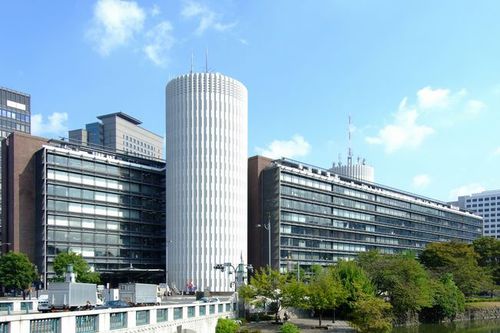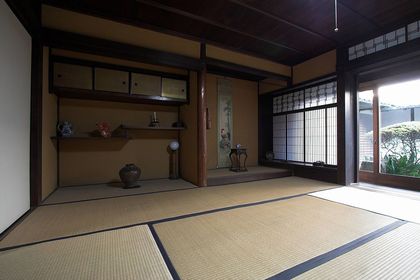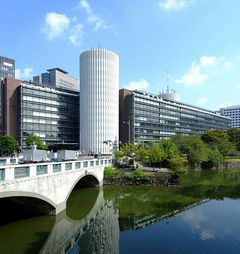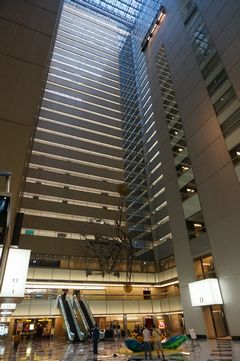September 16, 2014
From Energy-Saving Architecture to Energy Self-Sufficient Architecture: History of Energy-Saving Architecture in Japan
Keywords: Energy Conservation Newsletter
JFS Newsletter No.144 (August 2014)

Image by Wiiii Some Rights Reserved.
To address the challenge of reducing energy consumption and carbon dioxide (CO2) emissions of architectural structures, various efforts are being made both in Japan and elsewhere. We will introduce efforts being made in Japan, using excerpts from a book written by Hideharu Niwa, the title of which translates as "Energy Self-Sufficient Architecture Supporting Sustainable Low-Carbon Cities (published by Kousakusha in 2013)."
---------------------------------------
Energy-Saving Techniques of Traditional Japanese Housing
Traditional Japanese houses that use little fossil energy were basically passive houses, meaning they accommodated natural conditions. By existing with nature and using natural energy, these houses created and maintained comfortable indoor spaces without using fossil energy, and can provide us with valuable ideas for modern house planning.

Image by ignis Some Rights Reserved.
1. Accepting changes in indoor conditions
Changes in indoor temperature, etc., were considered normal in traditional houses. . People even enjoyed those changes. If we tolerate such changes, we can enhance our ability to rely on natural energy even in modern housing.
2. Drastically reduced environmental load
Traditional houses had almost no internal load. Thus, by interrupting solar radiation and curbing the penetration of solar heat from the outside, people could keep out summer heat using only ventilation. Even in modern architecture it is important to cut the cooling load at the source.
3. Natural energy controlling indoor conditions
It was once quite normal to create pleasant indoor conditions with natural ventilation and lighting, not depending on fossil energy. People often sprinkled water on the ground for cooling, making use of the way heat is absorbed by evaporating water. The efficient use of natural energy to create comfortable indoor conditions is still important even in modern architecture.
4. Natural materials
The walls, roofs and floors of houses in previous times were basically made of natural materials. These were zero-emission materials which decomposed and eventually turned back into soil. This can provide us with clues on how to solve current problems with resources and waste.
Energy-Saving Methods in Modern Architecture
In the 1900s, as ferroconcrete architecture became more popular, buildings increased in size and their internal volumes grew relative to their perimeter zone surface areas. Consequently, internal heat generation increased and the percentage of natural lighting and natural ventilation used decreased, making it difficult for people to rely on natural energy. At about the same time, electric lamps for general lighting and air conditioning units were developed, and large buildings started to focus on the use of artificial energy such as electricity.
In the late 20th century, stable supplies of electric energy were secured and fluorescent lighting became widely available at a rapid pace. Fewer buildings were being built with the high ceilings and shallow depths (distance from the building's outer perimeter to its center point), which take into consideration the use of natural energy, including natural ventilation and lighting. Meantime, high-rise buildings with low ceilings and deep depths -- that is, buildings with high volume efficiencies -- became mainstream.

Image by Wiiii Some Rights Reserved.
In the late 1950s, with the advent of large panes of glass for architecture, the realization of expansive buildings with large openings on exterior walls became possible. As if in response to this trend, technologies such as louvers and light shelves were developed to provide shielding from the direct rays of the sun and decrease the heat load.
The Oil Crisis and Energy-Saving Buildings

Image by Andywu476
Some Rights Reserved.
In the 1970s when buildings increased in size, atriums in office buildings prevailed as a method of providing an open environment. An atrium is a stairwell within a building that allows sunlight to penetrate. As offices with shallow depths are open and easy-to-use in terms of layout, the ideal depth was thought to be about 15-20 meters. The use of atriums was an effective technique to realize this in large buildings.
Improving on this idea, some high-rise buildings were built in a courtyard style, with small exterior-wall openings and an expansive atrium. These buildings adopted energy-saving methods that consisted of reducing the perimeter zone heat load and using the atrium for ventilation and lighting as a buffer space against the natural environment. Concurrently, the zero energy band control concept was introduced in an attempt to attain a coexistence of natural and artificial energy. With zero energy band control, an allowance is added to a preset air conditioning temperature so that within a certain limit artificial energy is not used.
In the 1970s, amid the energy crisis that followed upon two oil crises, there was demand for wide-ranging energy conservation measures in the field of architecture, such as setting air conditioners to 28 degrees Celsius, restricting luminance to 400 lux, and installing pull switches for each lighting unit. These were just temporary emergency measures for saving energy that sacrificed comfort and required a certain degree of patience.
In the late 1980s, environmental issues such as air pollution and global warming were raised from a long-term perspective, and energy-saving methods for buildings shifted to environmentally conscious ones using sustainable renewable energy.
Sustainable Development and Environmentally Friendly Buildings
After the term "sustainable development" was used in the Brundtland Commission's 1987 report, the importance of global environmental conservation became widely recognized. In the architecture field, eco-friendly building designs have been tried in an effort to minimize environmental impacts. These constitute experimental attempts to maintain comfortable indoor conditions with minimal use of fossil energy through skillful control of heat and solar radiation, and use of renewable energy.
Global Warming Prevention and Low-Carbon Buildings
According to the final figures for 2011, Japan's total greenhouse gas emissions had increased by 3.7 percent from their 1990 levels, but emissions from the service sector (including offices, sales and services) and the household sector had increased significantly, by 50.9 percent and 48.1 percent, respectively. Thus, reducing emissions from these sectors is a pressing issue.
Greenhouse gases are released at all stages of a building's life cycle, including designing, construction, maintenance, management, utilization, repair, demolition and scrapping, while most of the building-derived emissions come from energy consumption during building use. Since 1997, when the third Session of the Conference of the Parties to the UN Framework Convention on Climate Change (COP3) was held, much attention has been given to reducing greenhouse gas emissions during the entire life cycle of buildings.
Various attempts have been made to reduce CO2 emissions from buildings, for example, by extending their service life, using recycled materials and reducing building weight. In recent years, such buildings have been called "sustainable buildings."
The Present State of Energy-Saving, Sustainable Buildings
Compared to the average for ordinary office buildings in Tokyo, the unit energy consumption of leading energy-saving and sustainable buildings built after 2000 is about 40 percent less. However, fossil energy supplies the remaining 60 percent. To achieve energy self-sufficiency, it will be essential to make further energy-saving efforts and introduce renewable energy.
---------------------------------------
One of JFS's upcoming articles will feature energy self-sufficient architecture in Japan. Stay tuned!
Edit by Junko Edahiro
Related
"JFS Newsletter"
- 'Good Companies in Japan' (Article No.4): 'Eightfold Satisfaction' Management for Everyone's Happiness
- "Nai-Mono-Wa-Nai": Ama Town's Concept of Sufficiency and Message to the World
- 'Yumekaze' Wind Turbine Project Connects Metro Consumers and Regional Producers: Seikatsu Club Consumers' Co-operative
- Shaping Japan's Energy toward 2050 Participating in the Round Table for Studying Energy Situations
- 'Good Companies in Japan' (Article No.3): Seeking Ways to Develop Societal Contribution along with Core Businesses


